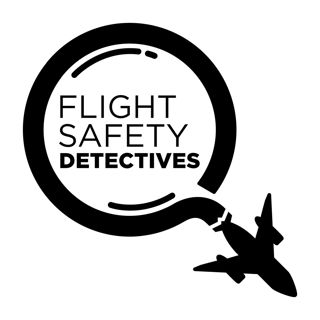
Criminalization Threatens Aviation Safety - Episode 227
As Boeing continues to be the subject of investigations and congressional hearings the concept of criminalization has come to the forefront. This could have a devastating impact on aviation safety in the U.S. Special guest and aviation attorney Mark Dombroff focuses on efforts to criminalize the investigation of aviation accidents and incidents. The effort to use criminal prosecutions to address aviation safety issues in the U.S. would dramatically impact the process of getting to the facts, including making witnesses more reluctant to come forward with details. Criminalizing will make the safety investigation process more difficult and less effective.While some in the legal community favor criminalization, it is not the approach used in most of the world. Aviation accident investigation focuses on understanding what happened and how to prevent similar events in the future. A criminal investigation would shift the goals to assigning blame and handing out punishment. Several notable past investigations came up during the discussion, including a fatal 2006 midair collision in Brazil involving a 737 and a corporate jet. The corporate jet pilots were detained in Brazil for several months and threatened with prosecution for almost 18 years. When TWA Flight 800 crashed, there was tension over whether the FBI or the NTSB would conduct the investigation. Don’t miss what’s to come from the Flight Safety Detectives - subscribe to the Flight Safety Detectives YouTube channel, listen at your favorite podcast service and visit the Flight Safety Detectives website. Want to go deeper with the Flight Safety Detectives? Join our YouTube Membership program for exclusive perks like members-only live streams and Q&As and early access to episodes. Your membership support directly helps John, Greg and Todd to deliver expert insights into aviation safety.Interested in partnering with us? Sponsorship opportunities are available—brand mentions, episode integrations, and dedicated segments are just a few of the options. Flight Safety Detectives offers a direct connection with an engaged audience passionate about aviation and safety. Reach out to fsdsponsors@gmail.com. Music: “Inspirational Sports” license ASLC-22B89B29-052322DDB8 Hosted by Simplecast, an AdsWizz company. See pcm.adswizz.com for information about our collection and use of personal data for advertising.
26 Juni 202444min

Missing Equipment and Inexperience Lead to Plane Crash - Episode 226
Missing equipment and inexperience led to a plane crash that killed 3. Precipitation, turbulence, and icing were factors in the crash of a Piper PA-30 Comanche in Oklahoma. The pilot did not have an instrument certification and was not able to handle the conditions.The pilot had a private pilot and multiengine rating but did not have instrument training. Todd Curtis, Miles O’Brien, and John Goglia discuss what may have driven the pilot to fly into deteriorating weather. “Getting there” seems to have been the focus rather than planning and preparation.The pilot was cruising at about 8,500 feet and climbed to as high as 16,500 feet. While the aircraft could provide supplemental oxygen, the equipment to use that system was not on board.The pilot likely climbed to escape a storm. He flew to an altitude where supplemental oxygen was required. The plane crashed and all 3 people on board were killed.Related Documents are available at the Flight Safety Detectives website. Don’t miss what’s to come from the Flight Safety Detectives - subscribe to the Flight Safety Detectives YouTube channel, listen at your favorite podcast service and visit the Flight Safety Detectives website. Want to go deeper with the Flight Safety Detectives? Join our YouTube Membership program for exclusive perks like members-only live streams and Q&As and early access to episodes. Your membership support directly helps John, Greg and Todd to deliver expert insights into aviation safety.Interested in partnering with us? Sponsorship opportunities are available—brand mentions, episode integrations, and dedicated segments are just a few of the options. Flight Safety Detectives offers a direct connection with an engaged audience passionate about aviation and safety. Reach out to fsdsponsors@gmail.com. Music: “Inspirational Sports” license ASLC-22B89B29-052322DDB8 Hosted by Simplecast, an AdsWizz company. See pcm.adswizz.com for information about our collection and use of personal data for advertising.
19 Juni 202422min

Fourth Incident for Hughes 369 Helicopter Proves Fatal - Episode 225
The fatal crash of Hughes 369 helicopter being used to trim trees has a backstory that gives insight into what went wrong. This workhorse of a helicopter apparently had damage from previous incidents.The NTSB investigation found cracks in an engine mount that were likely present before the crash. John Goglia and Todd Curtis look beyond the fatal accident and share three previous investigations involving this helicopter. Two involved a crash with serious structural damage or a hard landing. These events may have stressed the engine mounts. The fatal crash happened when the helicopter was in use for an operation that used a large 10-bladed saw to trim trees close to power lines. The helicopter went into a spin and low altitude and crashed, killing the pilot. This episode highlights the importance of knowing an aircraft's history. Studying previous events involving a particular aircraft could reveal issues that should be inspected more closely or more frequently. The required 100-hour and 300-hour inspections were completed for the helicopter at the center of this discussion. However, additional inspections would have been smart given the previous accident history of the helicopter.Related documents are found at the Flight Safety Detectives website. Don’t miss what’s to come from the Flight Safety Detectives - subscribe to the Flight Safety Detectives YouTube channel, listen at your favorite podcast service and visit the Flight Safety Detectives website. Want to go deeper with the Flight Safety Detectives? Join our YouTube Membership program for exclusive perks like members-only live streams and Q&As and early access to episodes. Your membership support directly helps John, Greg and Todd to deliver expert insights into aviation safety.Interested in partnering with us? Sponsorship opportunities are available—brand mentions, episode integrations, and dedicated segments are just a few of the options. Flight Safety Detectives offers a direct connection with an engaged audience passionate about aviation and safety. Reach out to fsdsponsors@gmail.com. Music: “Inspirational Sports” license ASLC-22B89B29-052322DDB8 Hosted by Simplecast, an AdsWizz company. See pcm.adswizz.com for information about our collection and use of personal data for advertising.
12 Juni 202430min

Training Flight Disaster - Episode 224
Training flight gone wrong! An examination of a February 2024 accident that involved an unstable approach, a tail strike, and a near collision with an airplane hanger.Both the instructor and student involved in the Cessna 172 accident survived. Their account of the event provides insights into how a routine training flight turned into a near disaster. The instructor's decision-making created a dangerous situation.Shortly before landing, ATC redirected the aircraft to a much shorter runway, and the instructor allowed the student to bring in the aircraft too high and too fast. The instructor then allowed the student to land instead executing a missed approach.After the student put the aircraft on the runway and braked hard enough to lock the brakes, the instructor took control of the aircraft, continued to apply brakes and pulled back on the control column hard enough to cause a tail strike.The instructor turned onto a taxiway near the end of the runway and took off again, barely missing a nearby hanger. Fortunately, the instructor was able to land the damaged aircraft.The Australian authorities reference FAA criteria for a stabilized approach in the accident report. The detectives share anecdotes that reinforce the importance of judging whether an approach is stable and being consistent with landing procedures. Don’t miss what’s to come from the Flight Safety Detectives - subscribe to the Flight Safety Detectives YouTube channel, listen at your favorite podcast service and visit the Flight Safety Detectives website. Want to go deeper with the Flight Safety Detectives? Join our YouTube Membership program for exclusive perks like members-only live streams and Q&As and early access to episodes. Your membership support directly helps John, Greg and Todd to deliver expert insights into aviation safety.Interested in partnering with us? Sponsorship opportunities are available—brand mentions, episode integrations, and dedicated segments are just a few of the options. Flight Safety Detectives offers a direct connection with an engaged audience passionate about aviation and safety. Reach out to fsdsponsors@gmail.com. Music: “Inspirational Sports” license ASLC-22B89B29-052322DDB8 Hosted by Simplecast, an AdsWizz company. See pcm.adswizz.com for information about our collection and use of personal data for advertising.
5 Juni 202424min

Electrical Failure Leads to 727 Crash in Pacific Ocean - Episode 223
The crew of a United Airlines 727 tried to turn back shortly after takeoff from Los Angeles, but did not make it back to the airport. The plane crashed into the Pacific Ocean.Greg Feith, Todd Curtis, and John Goglia discuss the crash of the 727-22QC in 1969. Electrical failures and electrical system design contributed to the plane crash. The accident happened on a night with limited visibility due to the weather.The aircraft had three electrical generators, but only two were working. Shortly after takeoff, the crew shut down one engine due to a fire warning. That move shut down one of the two working generators.John discusses the complexities of 727 electrical systems and other aircraft of the era. The NTSB found that total power loss occurred after all the electrical loads were placed on the one remaining generator. Don’t miss what’s to come from the Flight Safety Detectives - subscribe to the Flight Safety Detectives YouTube channel, listen at your favorite podcast service and visit the Flight Safety Detectives website. Want to go deeper with the Flight Safety Detectives? Join our YouTube Membership program for exclusive perks like members-only live streams and Q&As and early access to episodes. Your membership support directly helps John, Greg and Todd to deliver expert insights into aviation safety.Interested in partnering with us? Sponsorship opportunities are available—brand mentions, episode integrations, and dedicated segments are just a few of the options. Flight Safety Detectives offers a direct connection with an engaged audience passionate about aviation and safety. Reach out to fsdsponsors@gmail.com. Music: “Inspirational Sports” license ASLC-22B89B29-052322DDB8 Hosted by Simplecast, an AdsWizz company. See pcm.adswizz.com for information about our collection and use of personal data for advertising.
29 Maj 202445min

$4 Million Mistake on Air Force One - Episode 222
Oil and oxygen don’t mix on airplanes. A crew doing maintenance on the Air Force One oxygen system ignored safety procedures resulting in $4 million dollars of damage the plane.The damage was caused by maintenance activity on the oxygen system of a U.S. Air Force VC-25A, a 747 aircraft that regularly flies the President of the United States. This event occurred in 2016.John Goglia and Todd Curtis share evidence that crew did not follow the VC-25A's aircraft maintenance manual procedures for cleaning the tools, parts, and components before performing leak checks on the oxygen system. This is perhaps the highest profile incident of an aircraft damaged due to improper oxygen system maintenance procedures. John notes that failure to follow procedures is the FAA's top cause for maintenance problems in commercial aviation. Don’t miss what’s to come from the Flight Safety Detectives - subscribe to the Flight Safety Detectives YouTube channel, listen at your favorite podcast service and visit the Flight Safety Detectives website. Want to go deeper with the Flight Safety Detectives? Join our YouTube Membership program for exclusive perks like members-only live streams and Q&As and early access to episodes. Your membership support directly helps John, Greg and Todd to deliver expert insights into aviation safety.Interested in partnering with us? Sponsorship opportunities are available—brand mentions, episode integrations, and dedicated segments are just a few of the options. Flight Safety Detectives offers a direct connection with an engaged audience passionate about aviation and safety. Reach out to fsdsponsors@gmail.com. Music: “Inspirational Sports” license ASLC-22B89B29-052322DDB8 Hosted by Simplecast, an AdsWizz company. See pcm.adswizz.com for information about our collection and use of personal data for advertising.
22 Maj 202428min

2020 Midair Collision Revisited- Episode 221
New evidence calls into question the NTSB's conclusions – and our reporting in Episode 193 - about a 2020 midair collision. Video and other information shows that there were two helicopters in the area before the midair collision.Miles O'Brien, Todd Curtis, and John Goglia revisit the 2020 midair collision of a drone and a helicopter. The NTSB used a video shot by the drone to conclude that a helicopter seen at the beginning of the video later collided with the drone. When Todd recently used the video as part of a class he was teaching, he noticed a shadow that he could not explain. That led to lots of sleuthing and the realization of the involvement of a second helicopter. Safety concerns arise when one or more helicopters operate around a drone. In addition to this 2020 collision, a midair between two news-gathering helicopters in 2007 that killed everyone on both helicopters.Miles shares his experiences flying in situations where multiple helicopters are covering a breaking news story. Pilots of manned and unmanned aircraft need to coordinate closely to maintain safe operations.The NTSB should consider taking a second look and revising its report to address the aviation safety issues uncovered. John shares his experience on the NTSB Board and what it took to reopen an investigation when new information was available.Don’t miss what’s to come from the Flight Safety Detectives - subscribe to the Flight Safety Detectives YouTube channel, listen at your favorite podcast service and visit the Flight Safety Detectives website.https://flightsafetydetectives.com/2020-midair-collision-revisited-episode-221 Don’t miss what’s to come from the Flight Safety Detectives - subscribe to the Flight Safety Detectives YouTube channel, listen at your favorite podcast service and visit the Flight Safety Detectives website. Want to go deeper with the Flight Safety Detectives? Join our YouTube Membership program for exclusive perks like members-only live streams and Q&As and early access to episodes. Your membership support directly helps John, Greg and Todd to deliver expert insights into aviation safety.Interested in partnering with us? Sponsorship opportunities are available—brand mentions, episode integrations, and dedicated segments are just a few of the options. Flight Safety Detectives offers a direct connection with an engaged audience passionate about aviation and safety. Reach out to fsdsponsors@gmail.com. Music: “Inspirational Sports” license ASLC-22B89B29-052322DDB8 Hosted by Simplecast, an AdsWizz company. See pcm.adswizz.com for information about our collection and use of personal data for advertising.
15 Maj 202432min

Bad Pilot Decisions Kill - Episode 220
Two Piper airplane crashes show that pilots’ bad decisions can have devastating results. This episode covers two avoidable fatal crashes. A 1991 accident involves a Piper Seneca in Florida. The NTSB found that the two occupants were partially disrobed and no evidence that either were wearing seat belts or shoulder harnesses. The report makes clear that the two occupants were attempting to join the Mile High Club.In the second event, a Cessna 150 crashed in 2014 after the pilot took off at night with a very low ceiling. He was taking flash pictures. He crashed shortly after takeoff due to spatial disorientation. The pilot’s decision to fly in deteriorating conditions is similar to errors made by the pilot in the Kobe Bryant Crash.The pilot had a commercial and an instrument rating but was not current to fly at night or in instrument conditions, a classic case of a VFR pilot taking off in IFR conditions. The visibility conditions were so low that the pilot may not have any chance of landing at the departure airport.Pilots can be tempted to bend the rules in order to have some fun in the air. These lessons show that the results can be deadly.Related Documents are available at the Flight Safety Detectives website. Don’t miss what’s to come from the Flight Safety Detectives - subscribe to the Flight Safety Detectives YouTube channel, listen at your favorite podcast service and visit the Flight Safety Detectives website. Want to go deeper with the Flight Safety Detectives? Join our YouTube Membership program for exclusive perks like members-only live streams and Q&As and early access to episodes. Your membership support directly helps John, Greg and Todd to deliver expert insights into aviation safety.Interested in partnering with us? Sponsorship opportunities are available—brand mentions, episode integrations, and dedicated segments are just a few of the options. Flight Safety Detectives offers a direct connection with an engaged audience passionate about aviation and safety. Reach out to fsdsponsors@gmail.com. Music: “Inspirational Sports” license ASLC-22B89B29-052322DDB8 Hosted by Simplecast, an AdsWizz company. See pcm.adswizz.com for information about our collection and use of personal data for advertising.
8 Maj 202423min






















